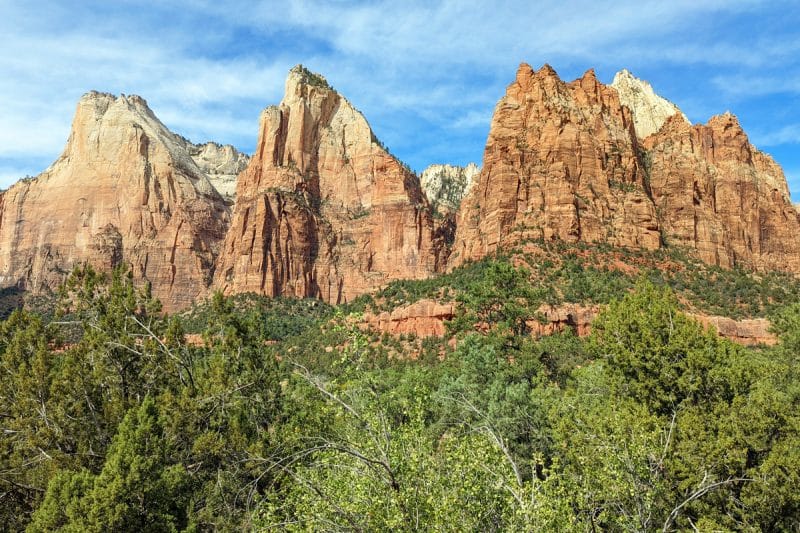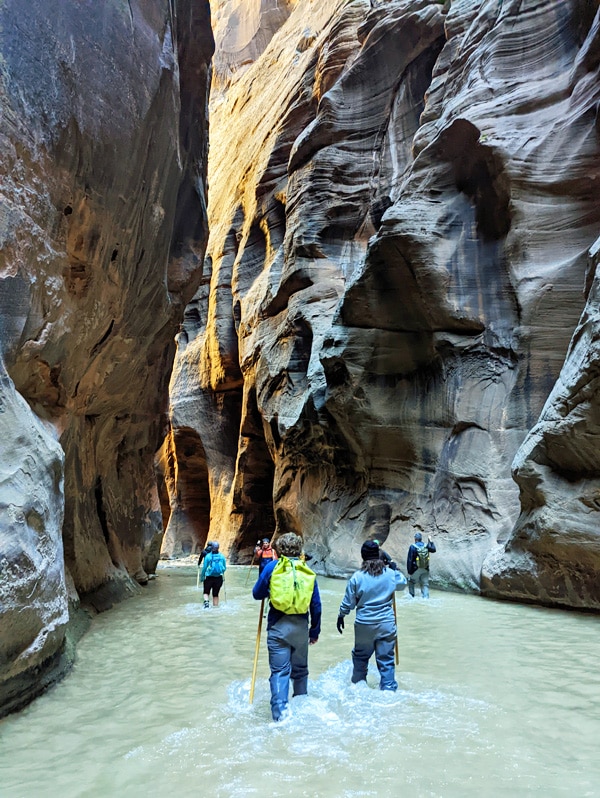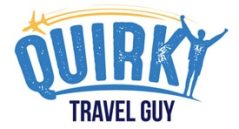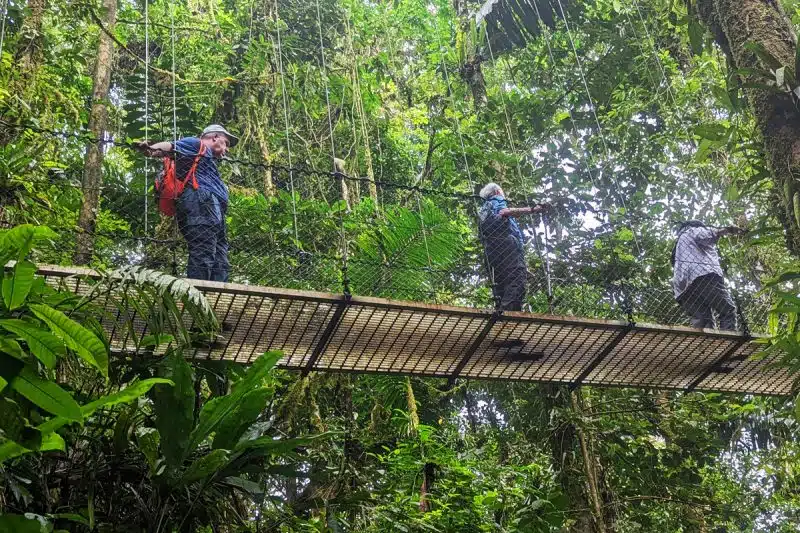Have you ever met anyone who’s gone to Zion National Park and not raved about it? The mountains, the canyons, and the red rocks all make for some incredible scenery.
I’m constantly in awe of the views throughout this southern Utah park, even when I’m just driving around.

Where are the very best views in Zion National Park? We’ve put together a detailed list, featuring mountain peaks, popular hiking trails, scenic canyons, and more, ranging from iconic spots like Angels Landing and the Narrows to some lesser-known viewpoints.
Read on for our list of recommendations, along with a map and tips for getting to each spot!
If you don’t have time to read the entire article, here’s a quick summary of our top viewpoint suggestions.
Quick Summary: The 15 Best Views in Zion National Park
15. Zion Canyon Visitor Center
14. Kolob Canyons Road
13. Lava Point Overlook
12. Weeping Rock
11. Checkerboard Mesa
10. Watchman Overlook
9. Court of the Patriarchs Viewpoint
8. Canyon Junction Bridge
7. West Rim Trail
6. Timber Creek Overlook
5. Cable Mountain
4. The Narrows
3. Canyon Overlook Trail
2. Angels Landing
1. Observation Point
To help you get around Zion more effectively, I recommend the Lonely Planet Guide to Zion & Bryce Canyon (Amazon link), which has itineraries, maps, and travel advice.
Map of Zion Scenic Points
The 15 points on our list have all been embedded into a Google map below. Save it for your trip!
The viewpoints marked in red require more than a one-mile hike to reach. The viewpoints in blue are more easily accessible — you can either drive to them, or get there with only a short walk.
When I think of Zion, I tend to split the park into four sections. There’s the main central area along Zion Canyon Scenic Drive, where most of the popular tourist attractions reside.
There’s a less-visited “middle section” on Kolob Terrace Road that leads to Hop Valley, Lava Point, and a few other spots.
There’s the even less-visited Kolob Canyons area in the far northwest corner of the park.
And there’s the Zion-Mount Carmel Highway on the eastern end of the park, featuring the Canyon Overlook Trail and a tunnel carved through the rock.
Our list features a few highlights from each of these areas, so you’ll have plenty to see, no matter which side of the park you’re exploring.
The 15 Best Views in Zion National Park
Here’s our detailed list of recommendations. This list includes something for every type of traveler. Some viewpoints are easily accessible from the main park road, while others require strenuous hikes to reach.
15 Zion Canyon Visitor Center
How to get there: Drive directly there on Route 9

Ok, we’re starting off with a simple view from the Visitor Center. Many national park visitor centers don’t have terribly impressive views, but this one is surrounded by mountains on most sides.
It’s a great first taste of the awesome scenery here, before you’ve even gotten deep into the park!
From spring through fall, Zion Canyon Scenic Drive is closed to vehicles, so you’ll want to park here at the visitor center and jump on one of the free shuttle buses.
14 Kolob Canyons Road
How to get there: Drive up I-15 to Kolob Canyons Road

The Kolob Canyons section sees far less traffic than the rest of the park, because it requires a lengthy drive up I-15. But when you get here, you’ll understand why it’s worth coming.
The views get more and more stunning as you drive up Kolob Canyons Road to reach Kolob Canyons Viewpoint.
The road features several pullouts. Stop at each of them and soak in these mountain views, because they are truly unforgettable.
The best view on this road comes on the hiking trail at the very top, the Timber Creek Overlook Trail. That trail has its own spot later on this list.
13 Lava Point Overlook
How to get there: From the town of Virgin, Utah, follow Kolob Terrace Road for 20 miles to Lava Point Road, which leads to the viewpoint

One of the best views in Zion National Park’s central Kolob Terrace Road section is Lava Point. At 7890 feet in elevation, this is the highest point you can drive to in Zion NP.
This is an area with ponderosa pine forests and an overlook where you can see the tall towers of rock in the distance that were formed when lava flows cooled and hardened a million years ago.
12 Weeping Rock
How to get there: Take the shuttle to stop #7 and follow the short Weeping Rock Trail

Even without any views, Weeping Rock would be worth visiting, because it’s a fascinating formation.
Water consistently trickles out of the rock where a layer of sandstone has deteriorated. Tourists come here to see the rock as it “weeps.”
The view here is tremendous, with the Great White Throne and other large rock formations in view from the end of the trail. It’s less than a half-mile from the shuttle stop to walk to Weeping Rock.
11 Checkerboard Mesa
How to get there: Drive the Zion-Mount Carmel Highway near the east park entrance

Checkerboard Mesa is an appropriate name for this natural feature, a piece of rock that appears to have checkered straight lines drawn into it.
This mesa looks a lot different from the other natural features of Zion, which are mostly reddish sandstone mountain peaks.
It’s just inside the east entrance of the park on Zion-Mount Carmel Highway. You can easily spot the mesa while driving, or pull over at the pullout to get a closer look.
10 Watchman Overlook
How to get there: Hike the Watchman Trail from the Visitor Center

One of the best simple hikes from the visitor center is the Watchman Trail, a modest 3-mile roundtrip trek that gains about 630 feet of elevation. The trail doesn’t actually go to the summit of the Watchman.
Instead, it goes to an overlook which provides a perfect view of the famous peak. You’ll also get a cool view looking down on the visitor center. Be prepared to battle the sun, as this hike has little shade.
9 Court of the Patriarchs Viewpoint
How to get there: Take the shuttle to stop #4 and walk to the viewing platform

The Court of the Patriarchs Viewpoint is among the most accessible spots on our list. No long hike is required.
Instead, this one merely requires getting off the park shuttle at stop #4 and strolling up a short path to the viewing platform.
From there, you can see the three big peaks named after Old Testament figures: Abraham Peak, Isaac Peak, and Jacob Peak, with the slightly shorter Mount Moroni in between. These sandstone cliffs tower over Birch Creek Canyon.
This is a quick and easy shuttle stop, and you can grab the next bus and move on to your next point of interest.
8 Canyon Junction Bridge
How to get there: From the visitor center, hike the Pa’rus Trail to the end, or take the shuttle to stop #3 and walk to Canyon Junction Bridge

The Pa’rus Trail is a paved, accessible walking path from the South Campground near the visitor center. It’s only 1.6 miles each way on a flat trail.
The trail crosses the Virgin River a few times and leads to Canyon Junction Bridge, which has a great view of multiple sandstone formations, including the East Temple (7709 feet high) and the Watchman (6545 feet.)
You can also reach this bridge by simply hopping off the shuttle at stop #3, although the shuttle bus skips stop #3 as it’s heading north, so you’d have to stop there coming south on the shuttle.
7 West Rim Trail
How to get there: Drive to the trail’s north end near Lava Point on Kolob Terrace Road, or reach the south end at shuttle stop #6

The full West Rim Trail runs for 14.5 miles, connecting Lava Point in the Kolob Terrace upper plateau area with the Grotto on Zion Canyon Scenic Drive.
A lot of hikers don’t traverse the entire thing, instead choosing to hike a few miles at either end of the trail.
You can find many different viewpoints along this trail. The north trailhead itself has a great view, which you can enjoy without any hiking at all.
The beginning upper plateau area has gorgeous views for miles, while Cabin Spring and the finishing section near Angels Landing are highlights on the south end of the trail.
From miles 6 through 9, you’ll be hiking near the edge of a canyon wall, with constant views down into the valley. What a remarkable hike!
6 Timber Creek Overlook
How to get there: Drive to the end of Kolob Canyons Road and hike the Timber Creek Overlook Trail

The Timber Creek Overlook is one of my personal favorite viewpoints in Zion National Park. It’s often overlooked because it’s in the more remote Kolob Canyons section of the park.
From the spacious parking lot, the hike covers just one mile, and it’s mostly flat, so it’s not strenuous. The trail remains on the high plateau, gaining just 100 feet of elevation.
This side of the park is very quiet. I didn’t encounter a single person on the trail. I didn’t hear anything except the sounds of nature.
It was so quiet I could hear crickets chirping and the flapping of a bird’s wings as it flew through the canyon, which echoed like the sound of a whip snapping.
The reward here is a view into the thickly forested finger canyons below, and glimpses of noteworthy peaks like Horse Ranch Mountain, Beatty Point, Timber Top Mountain, and Shuntavi Butte.
5 Cable Mountain
How to get there: Take the shuttle to stop #7, follow the Weeping Rock Trail to the East Rim Trail and then the spur trail to Cable Mountain

Though it’s not far from Weeping Rock and Observation Point, Cable Mountain isn’t a crowded hiking trail.
That’s partly because its neighbors are more famous, and partly because the hike here is complicated and requires 2000 feet of elevation gain in four miles (one-way.)
You start by following the same path as the Observation Point hike, along the Weeping Rock and East Rim trails through upper Echo Canyon. Eventually, the Cable Mountain spur trail appears.
This place has views down on Angels Landing and Observation Point. It also has old Cable Mountain Draw Works tramway equipment that was installed in 1901 to transport timber from the elevated land down into the canyon.
The equipment was abandoned in 1927. The NPS warns that the remaining structure on the cliff edge is unstable, and should not be touched. But it’s very cool to see it up at the top of the mountain.
An alternate hiking route to Cable Mountain starts at Stave Spring Trailhead outside the eastern border of the park, but you’ll need a four wheel drive vehicle to traverse those roads.
4 The Narrows
How to get there: Take the shuttle to stop #9 and follow the Riverside Walk to the Virgin River

While many of our recommended Zion views are found atop mountains, it can’t be denied that one of the coolest sights is walking through the Narrows.
This corridor carved by the Virgin River is one of the most famous destinations in any American national park.
Once you get beyond the 1-mile Riverside Walk, which begins the trek, there’s no longer an actual trail to follow. You’re literally wading through the river, which is usually just a couple feet deep.
Outfitters just outside the park rent out waterproof pants and boots to visitors who want them.
Walking through the Narrows, sploshing around with every step, looking up at thousand-foot walls on either side, was one of the most memorable moments I’ve had in any national park.
3 Canyon Overlook Trail
How to get there: Drive to the Canyon Overlook Trailhead, just east of the Zion-Mount Carmel Tunnel, and hike a half-mile to the viewpoint

In terms of bang for your buck, the Canyon Overlook Trail may be the best hike in the park. This is one of the best views in Zion National Park that requires minimal effort!
It’s only a half-mile walk from the parking lot on the Zion-Mount Carmel Highway next to the tunnel. You may see it referred to as Pine Creek Overlook.
At the end of the trail, you’ll find incredible views of canyon. This is an especially good hike for the “golden hour” just before sunset, when the lighting is spectacular.
2 Angels Landing
How to get there: Take the shuttle to stop #6, then hike the Angels Landing Trail (very steep hike, permit required)

One of Utah’s most famous hikes, Angels Landing is known mostly for the narrow ledge near its summit, requiring hikers to hold on to bolted chain guiderails to avoid a precipitous fall onto either side.
The hike gains 1825 feet in about 2.2 miles, making it a very strenuous trek. Permits are now required, because it used to get so crowded on some of the narrow sections that it was becoming dangerous.
The sights from up here looking down into the canyon are hard to believe.
1 Observation Point
How to get there: Take the shuttle to stop #7 and follow the Weeping Rock Trail and East Rim Trail

This place lives up to its name! You’ll want to stay up here as long as possible to take in the panoramic views.
From Observation Point, you’re actually looking down on Angels Landing, a full 800 feet above the famous landmark that stands across the canyon.
Getting to Observation Point means taking the shuttle to stop #7 at Weeping Rock.
The 4-mile hike up covers nearly 2000 feet of elevation gain, making for an exhausting trek. But you’ll forget all about that once you are sitting on what feels like the top of the world.
Observation Point deserves its place atop our list of the best views in Zion National Park.
Other Viewpoints Worth Considering
Quick mentions of a few spots that didn’t make our list but also provide interesting and/or beautiful views:
Deertrap Mountain: The Deertrap Mountain Trail provides some awesome views, and probably deserves a place in our Top 15.
We left it out because it’s an incredibly long hike (16 miles roundtrip from the Weeping Rock Trailhead), and because it’s views are similar to those at Cable Mountain.
Double Arch Alcove / Horse Ranch Mountain: Located at the end of Taylor Creek Trail in the Kolob Canyons area, this alcove is a landmark that features two natural arches built into the wall, one almost stacked on top of the other.
You can also see Horse Ranch Mountain (the highest point in the park at 8726 feet) while hiking the Taylor Creek Trail.
Connector Trail: Find this 9.6-mile out and back trail on Kolob Terrace Road. Much of the trail’s first half passes through flat, wide-open fields, with mountain peaks visible in the distance.
It eventually climbs through ponderosa pine forests to meet the Wildcat Canyon Trail.
FAQs and Tips About Finding Zion Scenic Areas
How does the Zion park shuttle work?

From spring to fall, due to overcrowding, personal vehicles are not permitted past Canyon Junction. You can hop on the free shuttle bus from the visitor center.
The shuttle goes to nine points of interest, including many of the viewpoints listed in this article.
The shuttle runs every 10-15 minutes, and it takes 40 minutes to go all the way from the visitor center to the final stop. It generally operates from 6 am to 8:15 pm, but it varies by month. See the current shuttle schedule.
What wildlife can you see in Zion?
Keep your eyes open as you ride the shuttle. I saw about 20 wild turkeys between Court of the Patriarchs and Zion National Park Lodge.
I also saw deer near the river between stops 8 and 9, and more deer right at the #9 Sinawava stop.
What’s the closest airport to Zion NP?
The closest airport is St. George Regional Airport (SGU), about 45 miles west of the heart of Zion. But this tiny airport only has one flights to Phoenix, Denver, Salt Lake City, and Dallas.
The most popular airport for Zion visitors is Harry Reid International Airport (LAS), formerly known as McCarran. The drive from there to Zion is about three hours.
Another option is Salt Lake City International Airport (SLC), which 4.5 hours north of the park.

When should I visit Zion NP?
Zion is a rare national park that is worth visiting any time of year. The summer months obviously see the highest visitation, and the weather is sunny, but sometimes it’s too hot.
Spring and fall may be ideal because temperatures are more comfortable.
Winter is cool too. Seeing snow on the Zion peaks is impressive. And there’s no need to rely on the shuttle system — you can drive the entire park road in the winter.
Where should I stay if I visit Zion?
The closest town to the heart of the park is Springdale, which is just a mile outside the park boundary. You can stay at one of the many hotels here and catch a bus or shuttle into the park, or drive to the visitor center.
Among the best Springdale hotel options:
Cable Mountain Lodge: Named after one of our recommended Zion viewpoints, Cable Mountain Lodge has studios and suites with a pool and hot tub. Check pricing and availability.
Flanigan’s Resort and Spa: For another upscale option, try Flanigan’s Resort and Spa. This place has a restaurant and spa in addition to comfortable rooms. Check pricing and availability.
Red Rock Inn: These cottages have mountain views and a free breakfast. Check pricing and availability.
Can you visit Zion as a day trip from Las Vegas?
Yes, but it will be a very long day, since the drive is 3 hours each way. You’d want to leave before sunrise and return after sunset.
Pick out one long hike (such as the Narrows or Angels Landing) and a couple of quick attractions (Weeping Rock, Court of the Patriarchs) to see.
Here’s our guide to doing a road trip from Vegas to Zion NP.
If you prefer not to drive, we recommend the following group tours from Las Vegas:
Zion National Park Small Group Tour With 6 Hours Explore Time: This tour is great because it gets you a full six hours in the park. You can hike Angels Landing if you have a permit. Otherwise, use the shuttle to explore as many destinations as you like, including Emerald Pools, the Narrows, the Grotto, and Temple of Sinawava. Check pricing and availability.
Zion and Bryce Canyon Day Tour From Vegas: This very popular and surprisingly affordable day tour from Vegas visits two parks for the price of one. The downside is that you only get about 45 minutes in Zion at the visitor center and Checkerboard Mesa. On the plus side, you’ll have 90 minutes to explore to wonders of Bryce Canyon National Park. Check pricing and availability.

What other attractions are nearby?
Zion is one of five Utah national parks, all of which should be on your itinerary if you have time. Visit Bryce Canyon, Canyonlands, Arches, and Capital Reef.
If you’re down for a road trip, Las Vegas is a good option. Vegas has the gambling culture, Seven Magic Mountains, and a bunch of quirky museums, including the Neon Museum, National Atomic Testing Museum, and the Pinball Hall of Fame.
Nevada’s Red Rock Canyon is a great road trip stop between Las Vegas and Zion.
Arizona also has a ton of great spots if you don’t mind driving a bit farther. The Grand Canyon is the ultimate highlight, but check out Petrified Forest National Park too, to see petrified wood from hundreds of millions of years ago.
Phoenix has some interesting attractions and lots of great outdoor activities. And Winslow has Standin’ On the Corner Park.
Is there anything else I should know about visiting Zion?
Always check conditions and weather forecasts before heading out to see any of these views in Zion. Trails can sometimes close due to rockslides. The Narrows is subject to dangerous flash floods.
What are your favorite views in Zion National Park?


